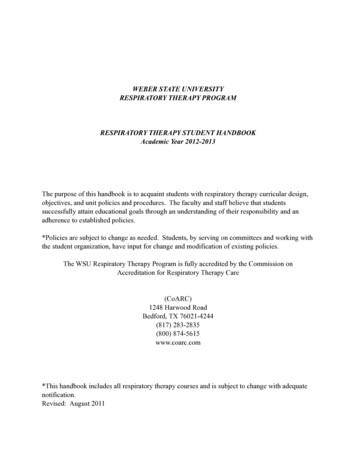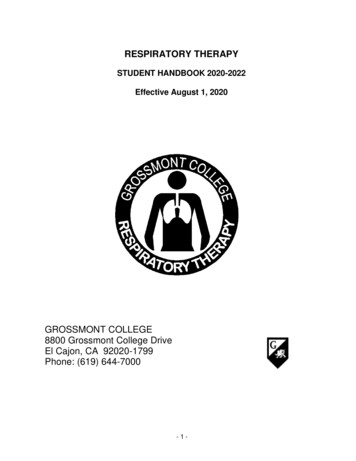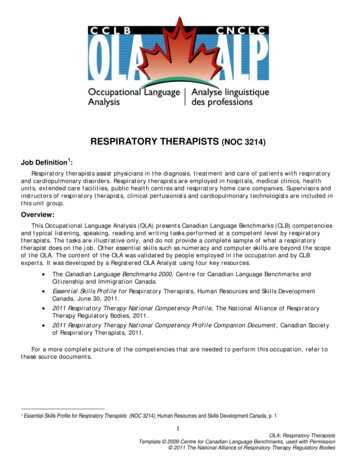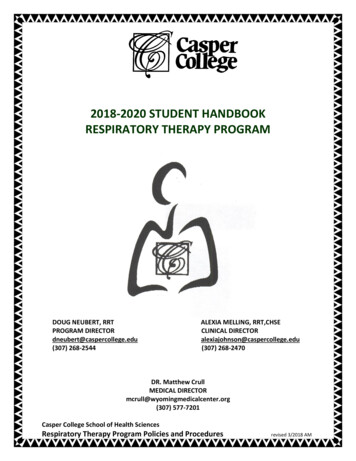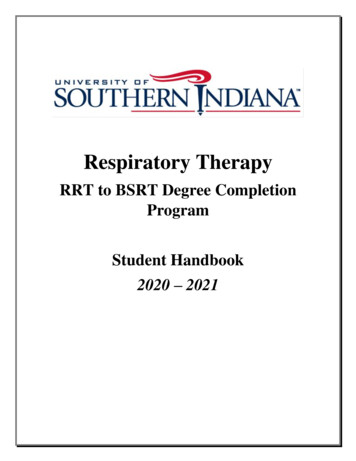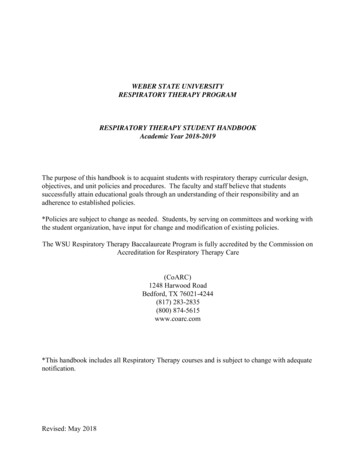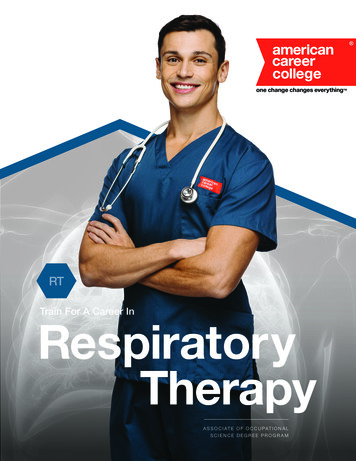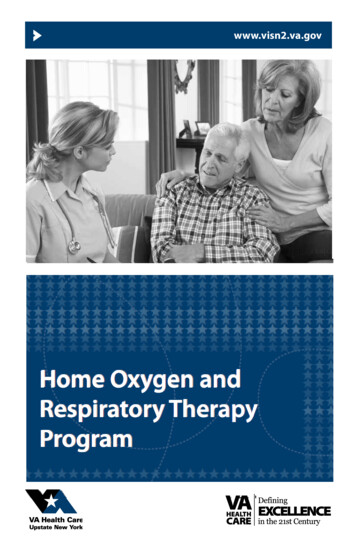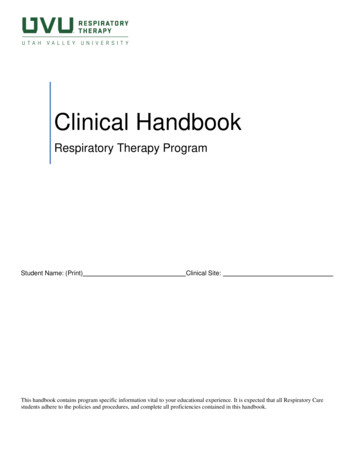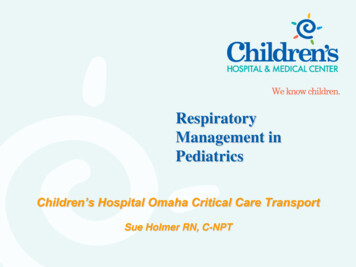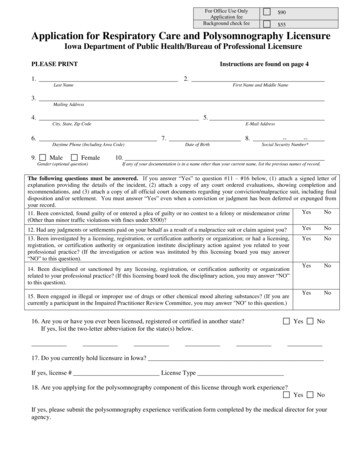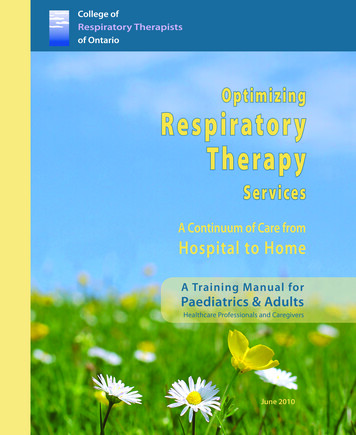
Transcription
OptimizingRespiratoryTherapyServicesA Continuum of Care fromHospital to HomeA Training Manual forPaediatrics & AdultsHealthcare Professionals and CaregiversJune 2010
Project TeamMary BaylissCarole HampDianne JohnsonRosanne LeddyMika NonoyamaChristine RobinsonMiriam TurnbullPartnersAcknowledgementsThe College of Respiratory Therapists of Ontario(CRTO) gratefully acknowledges the Ministry ofHealth and Long Term Care’s Health Force Ontariobranch for funding this collaborative initiativeentitled “Optimizing Respiratory Therapy Services:A Continuum of Care from Hospital to Home”.We would also like to thank the Toronto Central LocalHealth Integration Network (LHIN) for its support ofthis initiative.We would like to recognize the participation of ourpartners is this initiative.Central Community Care Access CentreProfessional Respiratory Home Care ServicesRespiratory Therapy Society of OntarioWest Park Healthcare CentreWe also acknowledge the valuable contribution ofthe following organizations in the development ofthis teaching package.FundingSupport for the development of thistraining manual was provided throughHealthForceOntario’s Optimizing Use ofHealth Providers Competencies Fund.Hamilton Health SciencesKingston General HospitalLondon Health Sciences CentreSt Michael’s Hospital, TorontoSick Kids, TorontoThe Ottawa Rehabilitation CentreVentilator Equipment Pool, KingstonWe acknowledge the following Respiratory Therapistsfor their dedication and tireless commitment to thisproject.A copy of this Training Manualis available fromCollege of Respiratory Therapists of Ontario180 Dundas Street West, Suite 2103Toronto, Ontario M5G 1Z8Tel: 416-591-7800Fax: 416-591-7890Toll free: 1-800-261-0528Email: questions@crto.on.caWeb site: www.crto.on.caCarlos BautistaMelva BellefountaineRob BryanNoreen ChanJanet FraserTerri HaneyChris HarrisMelissa HeleteaDave JonesJeannie KelsoGail LangAdrienne LeachKaren MartindaleRaymond MiltonGinny MylesPatrick NellisMargaret OddiRegina PizzutiFaiza SyedRenata VaughanSpecial thanks to the ProResp Clinical Team.Our thanks to all of the patients/clients, families and“hands on” caregivers without whom this projectwould not have succeeded.
OptimizingRespiratoryTherapyServicesA Continuum of Care fromHospital to HomeA Training Manual forPaediatrics & AdultsHealthcare Professionals and CaregiversJune 2010
DisclaimerInformation published by The College of Respiratory Therapists (CRTO) is provided foreducational purposes only and is intended for Ontario residents.This educational material does not provide medical advice. Information provided is notdesigned or intended to constitute medical advice or to be used for diagnosis of an individualpatient’s condition. Due to unique needs and medical history, patients are advised to consulttheir own healthcare professional(s) who will be able to determine the appropriateness of theinformation for their specific situation, and will assist them in making any decisions regardingtreatment and/or medication.Specific products, processes or services. Reference to, or mention of, specific products, processesor services does not constitute or imply a recommendation or endorsement by CRTO and/or itscontributors.Links to other sites are provided as a reference to assist you in identifying and locating otherInternet resources that may be of interest. Please remember that Internet resources are nosubstitute for the advice of a qualified healthcare practitioner. We do not assume responsibility forthe accuracy or appropriateness of the information contained in other sites, nor do we endorsethe viewpoints expressed in other sites.Use of this educational material is encouraged, all we ask is that you give credit to the CRTOand this project*.Should you identify any areas that require revisions or updates please let us know.* Support for the development of this training manual was provided through HealthForceOntario’s OptimizingUse of Health Providers Competencies Fund. Please refer to the back cover of this educational package to view acomplete list of the project partners.
Introduction to ManualIntroduction to the CD ResourcesGlossary of TermsIntroduction &Glossary of TermsSection #1: Introduction & Glossary of TermsSection #2: Healthcare ProfessionalsHealthcareProfessionalsDischarge Identification & PreparationIdentification and Preparation ToolDischarge ChecklistsPreparation for ICU DischargePreparation for Hospital DischargeSection #3: Patients/Clients & CaregiversPulmonary Clearance TechniquesPulmonary Clearance TechniquesEmergency Contacts and PlanningEmergency Contacts and PlanningUseful Web ResourcesEmergency Preparedness Guide forPeople with Disabilities/Special NeedsPatients/Clients& CaregiversEducation ChecklistsVentilation & Tracheostomy CareRoutine TasksHome Ventilation &My Education Checklist and Learning LogTracheostomy Care (for Adults)Oximeter Teaching ChecklistNon-Invasive Positive PressureVentilation (for Adults)TroubleshootingHome Ventilation &Troubleshooting GuideTracheostomy Care (for Paediatrics)Section #4: AppendicesAppendix BQuick Reference Guide to LTV 1200/1150 Series VentilatorsAppendix CQuick Reference Guide to LTV 900, 950 & 1000 Series VentilatorsAppendicesAppendix AAssistive Devices ProgramEquipment/Supply Authorization Form (Sample)
Introduction &Glossary of TermsSection #1: Introduction & Glossary of TermsIntroduction to ManualIntroduction to the CD ResourcesGlossary of TermsHealthcareProfessionalsSection #2: Healthcare ProfessionalsDischarge Identification & PreparationIdentification and Preparation ToolDischarge ChecklistsPreparation for ICU DischargePreparation for Hospital DischargePatients/Clients& CaregiversSection #3: Patients/Clients & CaregiversEducation ChecklistsVentilation & Tracheostomy CareRoutine TasksHome Ventilation &My Education Checklist and Learning LogTracheostomy Care (for Adults)Oximeter Teaching ChecklistNon-Invasive Positive PressureVentilation (for Adults)TroubleshootingHome Ventilation &Troubleshooting GuideTracheostomy Care (for Paediatrics)Pulmonary Clearance TechniquesPulmonary Clearance TechniquesEmergency Contacts and PlanningEmergency Contacts and PlanningUseful Web ResourcesEmergency Preparedness Guide forPeople with Disabilities/Special NeedsAppendicesSection #4: AppendicesAppendix AAssistive Devices ProgramEquipment/Supply Authorization Form (Sample)Appendix BQuick Reference Guide to LTV 1200/1150 Series VentilatorsAppendix CQuick Reference Guide to LTV 900, 950 & 1000 Series Ventilators
Introduction to ManualIntroduction to the CD ResourcesGlossary of TermsIntroduction &Glossary of TermsSection #1: Introduction &Glossary of TermsHealthcareProfessionalsPatients/Clients& CaregiversAppendices
Introduction &Glossary of TermsHealthcareProfessionalsPatients/Clients& CaregiversAppendicesSection #1: Introduction &Glossary of TermsIntroduction to ManualIntroduction to the CD ResourcesGlossary of Terms
IntroductionIntroduction & Glossary of TermsIntroduction to the ManualMechanical ventilation was first developed during the polioepidemic in the 1950s when patients were placed in an ironlung. Today we use positive pressure ventilation with anendotracheal tube or a tracheostomy tube. For the majority ofpatients, ventilation is usually short term and is discontinuedafter the respiratory or ventilatory failure has resolved. Mostpatients are weaned off the ventilator with no problems.However, for some patients weaning is a challenge.If a patient cannot be weaned off the ventilator they aredeemed ‘ventilator-dependent’. Chronic ventilated patients canbe found in acute-care hospitals, ventilator step-down units,long term care facilities, and at home. It is ideal and safe totransition stable, chronically ventilated patients to their homes.A stable, ventilator dependent patient can be transitioned successfully from the ICU to home, or along term care facility. This shift from acute care to home care has resulted in improved quality oflife, decreased morbidity and mortality, and reduced care costs. Patients and families report thatthey are happier at home and have a better quality of life.The intent of this document is to assist respiratory therapists and other healthcare providers totransition chronically ventilated individuals from hospital to the community. A successful hospitalto-home transition requires careful planning, and plenty of patient and family education. Prior toplanning the transition, the patient must meet discharge criteria, such as being medically stable.These criteria can be found in this manual. For a smooth transition to occur, the patient needs asupportive family, caregivers and a medical team that communicates well. Once the ICU dischargecriteria are met, the process of educating the patient and caregivers can begin. The EducationChecklist and Learning Log will assist the educator and learner track the education process.It is important to observe the caregivers participating in the care of the patient, while thepatient is in the acute care setting. It is critical as a healthcare provider to document the learner’scompetency. A number of checklists have been provided in this manual to assist with thisdocumentation requirement. All must be competent and comfortable prior to discharge.The education process can take 2 - 4 weeks to complete, prior to a patient’s discharge. To ensurethe skills have been mastered, and to provide ongoing support, a comprehensive follow up plan isthen continued within the community.
IntroductionIntroduction & Glossary of TermsThe material provided to the patient includes basic anatomy and physiology of the respiratorysystem, ventilator parameters, alarms, circuit changes, and backup power sources. Also coveredare suctioning, stoma and tracheostomy care and how to respond in an emergency. Thisinformation is found in the Home Ventilation & Tracheostomy Care manuals.There is also a Troubleshooting Guide, as an additional reference. For those patients onnon-invasive ventilation refer to the Non-Invasive Positive Pressure Ventilation guide.There are other tools and checklists to help youprepare the patient, their families and caregivers.The Useful Web Resources and Glossary of Terms canalso be helpful. Team meetings need to take place,prior to and following discharge, between the acutecare healthcare providers and the Community Careworker.The intent of this document is to assist respiratorytherapists and other healthcare providers totransition the chronically ventilated individual fromthe hospital to the community. If you have anysuggestions or comments about this manual pleaseforward them to The CRTO.180 Dundas Street West, Suite 2103Toronto, Ontario M5G 1Z8Tel: 416-591-7800Fax: 416-591-7890Toll free: 1-800-261-0528Email: questions@crto.on.caWeb site: www.crto.on.caIntroduction to the CDThe CD, found in the inside back cover, contains allthe information and worksheets that are presentedhere in this manual. The materials are sorted by ‘tab’or topic and are ready for print. To view the files, youmust have Adobe Reader software. To obtain AdobeReader, visit, ryTherapyServicesA Continuum of Carefrom Hospital to HomeRESOURCE CDA Training Manual for Paediatrics & AdultsHealthcare Professionals, Patients/Clients and CaregiversJune 2010
Glossary of TermsIntroduction & Glossary of TermsGlossary of TermsThe following is a list of words that you will find in the manual. Some of the terms are things youmay hear your healthcare worker say. Always ask if you do not understand something.AAerosol: Solution that is given in a mistApnea: Not breathingCardiopulmonary resuscitation (CPR):Artificially supporting breathing and thecirculationAntibiotics: Medicines that fight infectionsCarina: The point of where the right and leftbronchi separateArtificial nose: A device that warms andmoistens the airCatheter: A small tube placed inside the bodyto add or remove liquidsArtificial airway: A cut made in the trachearesulting in an opening that bypasses thenose and mouth. Also called “trach” or“tracheostomy”CPAP: A ventilation mode that helps a patient’sown breathing efforts. Stands for continuouspositive airway pressureAspiration: Food or liquid breathed into theairway instead of swallowedAsthma: Difficult breathing with wheezingthat is caused by swelling or spasms of theairwaysBCuff: The inflatable balloon on some trachtubesCyanosis: A bluish color of the skin due toreduced oxygen in the bloodDDecannulation: Removal of the trach tubeBacteria: GermsDiaphragm: The big muscle below the lungsthat controls breathingBacterial: Caused by bacteriaDysphagia: Difficulty swallowingBreathing bag: Ventilating bag used formanual resuscitationDyspnea: Labored or difficulty breathing,shortness of breathBronchi: The two main branches leading fromthe trachea to the lungsCCap: A small cap used to plug the trachopeningCannula: The tube part of the trach tubeCarbon Dioxide (CO2): Gas eliminated fromthe lungs with exhalationEEdema: Swelling of tissue.Encrustation: Hard and dried mucus that canbuild up around the inner cannula.ENT: It is a term used for type of doctor thatspecializes in the ‘ear nose throat’. ENT doctorsdo tracheotomy surgery
Glossary of TermsIntroduction & Glossary of TermsET tube (endotracheal tube): A tube used toprovide an airway through the mouth or noseinto the trachea.Home healthcare supplier: Also called medicalequipment supplier. They provide equipment,oxygen, trach care supplies.Epiglottis: “Trap door”. A piece of cartilage thathangs over the larynx like a lid and stops food,and liquids from going down into the lungsHumidity: Moisture in the airEsophagus: The tube between the throat andthe stomachExhale: To breathe outExtubation: Removal of the endotracheal tubeHydrogen peroxide (H2O2): Mild cleaningagentHypoventilation: Reduced rate and depth ofbreathingHypoxemia: A low amount of oxygen in thebloodExpiration: Breathing out of air from lungsIFFenestrated: Having an opening in the trachtube to allow speechFenestrated inner cannula: An inner cannulawith holes in it. This lets air go from the trachtube up to the mouth, and nose. The outercannula must also have holes in it to workFenestration: A single hole or pattern ofsmaller holesFlange: Part of the trach tube, also called theneck plateGGlottis: The sound producing part of thelarynx that consists of the vocal cordsHHeat moisture exchanger (HME): A filterdevice that fits into the end of the trach tubeto warm and moisten the air the patientbreathesHome healthcare professional: Individualwho gives care at homeInflation line: The thin plastic line attachedto trach tube balloon on one end and pilotballoon on the other. It is used to inflate anddeflate the trach tube balloon (cuff ).Inflation syringe: A plastic syringe withoutneedle used to inflate the trach tube balloon(cuff )Inhale: To breathe in.Inner cannula: The inner removable tube thatfits inside the outer cannula. May be removedto clean or exchanged with different innercannula.Inspiration: To breathe inIntubation: Placement of a tube into thetrachea to help with breathing.LLarynx: “Voice box” or “Adams apple”. Is just ontop of the trachea.Lumen: The inside of the trach tube throughwhich air passes.
Glossary of TermsMMucous: Slippery fluid that is made in thelungs and windpipeMm: Short form for millimeter. One millimeterequals .039 inchesIntroduction & Glossary of TermsRetractions: Pulling or jerky movement ofthe chest and neck muscles. It’s a sign ofrespiratory distressSSecretions: Another word for mucous.NNebulizer: A machine that puts moisture andor medicine into the airway and lungsNeck plate: Part of the trach tube that sitsagainst the neck, also called the flangeSpeaking valve: A one way valve that lets aircome into the trach tube when you breathein. When you breathe out, the valve closessending air out past the vocal cords andthrough the mouth so speech is possible.Nosocomial infection: An infection that yougot during your hospital staySpeech language pathologist: A persontrained to help with speaking and swallowingproblemsOStoma: The hole in the neck where you insertthe trach tubeObstruction: BlockageObturator: The guide that goes in the trachtube to help insert the tube into the tracheaOuter cannula: The main tube with neck platethat is placed into the tracheaOximeter: Equipment that monitors theamount of oxygen in the bloodOxygen: A gas that the body needs to stayaliveSterile: Very clean and free from germsSuctioning: One way to keep the inside of thetrach tube clean and free of mucus. A smallcatheter is connected to a suction machineand placed into the trach tube to removemucousSwivel neck plate: A neck plate that can swivelup and down and/or side to side. Allows forgreater range of head and neck movementwithout discomfort.Syringe: Device to measure medicinePPatent: Open, clear airwayTPneumonia: Swelling of the lung that is oftencaused by germsTrach: An opening into the tracheaRTrachea: “Windpipe”. The tube through whichair flows between the larynx and the lungsRespirologist: A doctor who looks after thelungsRespite: A break for caregivers who care for adisabled family member at homeTrach mask: A device that fits on the end ofthe trach tube to provide moistureTracheal wall: The inside lining of the tracheaTrach Tube: A tubular device placed into thetrach
Glossary of TermsTrach Ties: Cotton twill or Velcro tapes used tohold the trach tube in place. Connects to theslots in the trach tube neck plateVVentilator: A machine that helps a personbreatheVirus: A germ that can cause illnessViscid: Thick or stickyVocal cords: Two strips of tissue in the voicebox in the neck, which allows vocalizationWWheeze: A whistling sound coming from thelungs because of a narrowing in the wind pipeor airways.Introduction & Glossary of Terms
Discharge Identification & PreparationIdentification and Preparation ToolDischarge ChecklistsPreparation for ICU DischargePreparation for Hospital DischargeIntroduction &Glossary of TermsSection #2: Healthcare ts& CaregiversAppendices
Introduction &Glossary of TermsHealthcareProfessionalsPatients/Clients& CaregiversAppendicesSection #2: Healthcare ProfessionalsDischarge Identification & PreparationIdentification and Preparation ToolDischarge ChecklistsPreparation for ICU DischargePreparation for Hospital Discharge
Discharge Identification & PreparationDischargeIdentification& PreparationIdentificationandPreparationTool
Discharge Identification & PreparationDischargeIdentification& PreparationNotes
IdentificationandPreparationTool
Identification and Preparation ToolHealthcare ProfessionalsEvaluation and Discharge PlanningDischarge AssessmentThe following is a high-level approach the interdisciplinary team can use during thepreliminary stages of identifying a candidate for home or community placement.Assessment of the Home EnvironmentAssessment includes geographic location, available space, and accessibility. A home to go toHome environment prepared in advance to accommodate the patient’s needsAdequate number of grounded electrical outletsRespiratory equipment supplier is aware of individualSturdy bedside table for the ventilator placementAssessment of CaregiversCaregivers must be motivated and able to learn the care routines. Patient is able and willing to supervise/direct care Individual is able and willing to participate in self care, or has sufficient caregiverassistance to adequately meet medical, respiratory, and personal care needsEducation and TrainingThere is a comprehensive education plan with learning objectives and evaluation forindividual, family and caregivers. Caregivers identified and trained prior to discharge (See Home Ventilation & Tracheostomy Care, and Education Checklist and Learning Log provided in thismanual)Adequate nutrition program is in placeSuccessful and stable trials: for at least two weeks prior to discharge with no changesB On home equipment ventilator prior to discharge, (e.g. ventilator, monitor,oxygen, if applicable)B Leaving the hospital setting with home caregiversPage 1
Identification and Preparation ToolHealthcare ProfessionalsAssessment of ResourcesThis includes professional services, support systems, individual’s financial resources. Adequate financial resources and mechanisms for reimbursement identified prior to dischargePotential referrals in place: Respirologist, Occupational Therapist, Physical Therapist,Social Worker, Registered Dietitian, Pharmacist, Community Care Access Centres(CCAC)Appropriate application forms completed:B Assistive Devices Program:o Tracheostomyo Ventilatoro Enteral feeds, if applicableB Home Oxygen Program, if applicableB Special services at homeB Handicapped parking permitsB WheelchairContact the Ventilator Equipment Pool (VEP) to discuss the most appropriateequipment available and lead time for deliveryPlan of CareA written management plan for respiratory, medical care, and emergencies. Individual is medically stable: oxygen requirement less than, or equal to 40%; stable blood gases; mature tracheostomy and no events requiring CPR for at least onemonthComprehensive discharge plan in placeThe treatment plan for all medical conditions is in placeB Plan does not require frequent changesB Plan is transferable to the communityDischarge planning meetings in place, including the individual, caregivers, healthcareteam and community servicesPage 2
Identification and Preparation ToolHealthcare ProfessionalsTeam MeetingsInitial team meeting are to take place while the ventilator assisted individual (VAI) is in thehospital.First Team MeetingPrimary aims of this meeting are: Determine the short and long term goalsIdentify issues and potential barriers to dischargeCreate plans to manage issues and potential barriers to dischargeComplete feasibility assessment of required community supportIdentify additional funding opportunities for the patientTeam members should include the individual, their caregivers and the inter-professionalteam: IndividualFamily and caregiversMost responsible physicianNurse (RN)Community Respiratory Therapist (RT)Social Worker (SW)Physical Therapist (PT) Speech Language PathologistOccupational Therapist (OT)Registered Dietitian (RD)PharmacistCCAC Case ManagerDischarge planner Second Team MeetingPrimary aims of this meeting are: Determine if discharge to home or community facility is achievablePrioritize goals and timelines; those to be achieved prior to dischargeDetermine a realistic discharge dateDelineate roles and responsibilities for all team members, including the caregiver andfamilyB Care plansB Funding applicationsB Discharge guidelinesB Learning needs assessmentsB Education training programsB Equipment acquisitionPage 3
Identification and Preparation ToolHealthcare ProfessionalsAdditional team members at this meeting should include the community care providers: Community RTCommunity PTCommunity OTNursing agency providerFollow up MeetingsPrimary aims of this meeting are: Monitor progress toward goalsUpdate the patient and caregiversIdentify other barriers to discharge and develop a resolution planCommunicate among the inter-professional disciplinary teamPage 4
Identification and Preparation ToolHealthcare ProfessionalsPlacement Considerations in the HomeAdequate Daily Care CoverageIn addition to the care provided by the caregiver(s), the patient may receive additional carehours through CCAC. Access to immediate assistance is recommended for any individual whorequires 24 hours ventilation or is fully dependent in their activities of daily living. This can bea trained community care provider, such as a Registered RT, Nurse, PSW or trained familymember.Individuals who live in Ontario who require suctioning or catheterization as part of theirnormal daily routine have a legislated exemption in the Regulated Health Professional Act(RHPA) allowing non-registered professionals to provide this service, provided they arecompetent to do so.Additional ConsiderationsMobilityA VAI may require a wheelchair with ventilator and oxygen carrying capacity. The vehicleused for mobility must be able to safely carry a ventilator and external battery withouttipping. Home ventilators can weigh up to 35 lbs. Ventilator shelves can be attached tosome standard wheelchairs, but some of these chairs may not be wide enough orbalanced enough to hold the additional weight. Often a VAI has their own wheelchair thatcan be adapted by the supplier to carry the ventilator and battery. If this is not possible,an application for a customized wheelchair with ventilator carrying capability can bemade.Assessment and applications are usually made by the OT or PT and signed by thephysician. The chair supplier will need the ventilator and battery dimensions. Informationthat can be obtained from the RT.Other mobility devices may be required, such as ambulation aids and positioning devices(lifts).Applying early in the process will reduce delays. Check with the equipment provider forthe anticipated delivery date.Page 5
Identification and Preparation ToolHealthcare ProfessionalsEquipment AcquisitionThe Ministry of Health and Long-Term Care (MOHLTC) funds 75% of the cost ofrespiratory supplies through the Assisted Devices Program (ADP). The remaining 25% isthe responsibility of the individual.Contact the VEP or alternate provider for details on equipment acquisition. Note: someindividuals are not eligible for equipment through the VEP. For example, patientsdischarged to long term care facilities do not have access to VEP equipment. See VEPwebsite for more information on eligibility http://www.ontvep.ca.Home Mechanical VentilatorsA VAI discharged to the community is provided with: Ventilator(s)Battery chargerHeated humidifierExternal battery for emergency power onlyBattery cableRe-useable ventilator circuitsThe cost of this equipment is 100% covered by the MOHLTC, through ADP. Applicationsmust be signed by the physician.The VAI should have completed several successful trials on a home mechanical ventilator,before setting them up for indefinite use.Other Respiratory SuppliesRequests are made by the home respiratory care service, to the ADP. This equipment mayinclude: Apnea cardiorespiratory monitors Compressors for aerosolized medication deliveryPostural drainage boardsSuction machines Tracheostomy suppliesPercussorsResuscitatorsPositive airway pressure systems75% of the cost of this equipment may be covered by the MOHLTC. The remaining 25% isthe responsibility of the individual.Page 6
Identification and Preparation ToolHealthcare ProfessionalsSome equipment, although necessary for some VAIs, may not be funded through ADP.The following equipment is not funded:B cough-assist devicesB oximeters for individuals 18 years or olderB 12 volt batteries for mobility purposesOther Medical SuppliesOther medical supplies may be necessary in the community setting and eligible for ADPfunding e.g. enteral feed equipment. Check with the interprofessional healthcare teamfor details.Individual, Home Care Providers and Family EducationA successful discharge requires a simplified and comprehensive transfer of care routinesfrom healthcare team to the community provider team. Ideally the community teamwould receive the transfer of skills within the acute care facility. This allows them to be indirect contact with the individual and work closely with the acute care team. This trainingtechnique serves to increase the confidence and comfort of both the community careproviders, the individual and the caregivers.Information provided in respiratory teaching packages typically should cover: Tracheostomy and ventilator care Individual-specific training checklist that must be completed prior to discharge; can also be used as a scheduling guideEmergency guidelines that are provided to address common problems that may arisewithin the home environmentRespiratory EducationThe training should include, but is not limited to: Respiratory anatomy and physiology Hands-on training with tracheal suctioning Ventilator troubleshooting and maintenance Tracheostomy tube cuff care; changing if applicable Page 7Use of the manual resuscitator bagSwitching to ventilator batteryCharging the ventilator batteryCircuit assemblyEmergency planningCleaning of equipmentVolume augmentation manoeuvres
Identification and Preparation ToolHealthcare ProfessionalsEmergency Plan and Recommended Physician CoverageEmergency guidelines are provided to address common problems that may arise withinthe home environment. These guidelines are provided for each individual and placementsituation. Included are: what should be done; who should do it; what services should becalled, etc.The individual's wishes regarding resuscitative efforts should be addressed and beavailable in the home for emergency response personnel.The individual must have: A Family Physician who will manage day to day general medical needs A Respirologist or other consultant who has expertise in mechanical ventilation, to manage ventilation needsA “home-base” hospital location should an emergency occur that cannot be solved athome. Ideally this is the acute-care facility discharging the individual homeFor those caregivers wishing for Cardiopulmonary Resucsitation (CPR) certification,discuss this training with your healthcare provider.Guidelines are provided that include contact numbers of home care providers andsupport services.Communication and Transfer of Information to Community ProvidersWith the individual’s consent, the discharge team should ensure the community carepartners receive information on: Medical history Written consent Care plan, preferences, daily routines, typical patterns where interventions are requiredTransfer and discharge notes from the discharging
Respiratory Therapy Services A Continuum of Care from Hospital to Home A Training Manual for Paediatrics & Adults Healthcare Professionals, Patients/Clients and Caregivers June 2010 Introduction Introduction & Glossary of Terms 180 Dundas Street West, Suite 2103 Toronto, Ontario M5G 1Z8 Tel: 416-591-7800 Fax: 416-591-7890 Toll free: 1-800-261-0528
